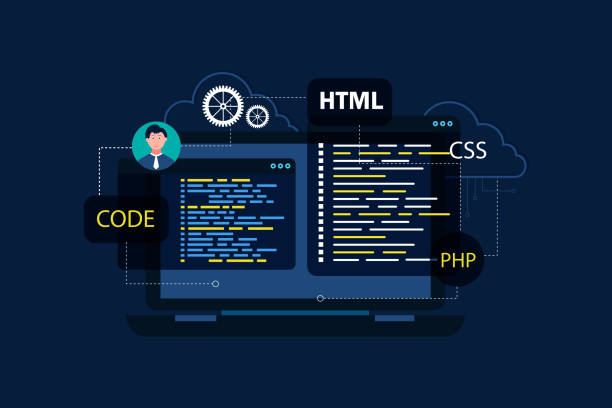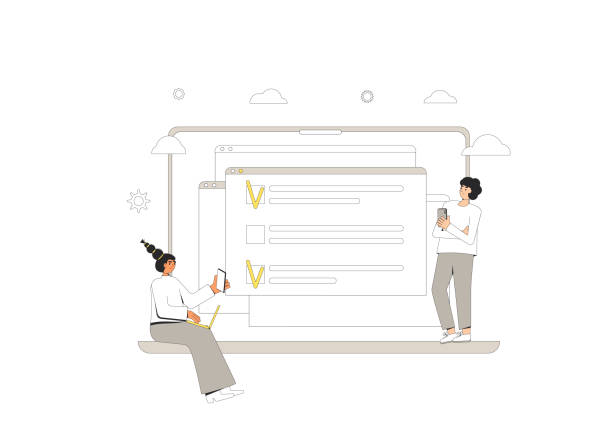An Introduction to the Importance of Secure Web Design in the Digital World

In the current era, an online presence is vital for any business or individual.
However, along with this expansion, cyber threats have also increased unprecedentedly. Therefore, website design is not limited to mere aesthetic appeal or functionality; rather, secure website design has become a necessity.
This topic, far beyond a minor issue, is a main pillar that ensures the stability, credibility, and user trust in an online system.
Understanding the importance of this issue is the first step towards building a resilient digital infrastructure.
The goal of secure web design is to protect sensitive data, prevent unauthorized access, and ensure the correct and uninterrupted operation of the website.
This includes various aspects such as network security, secure coding, proper server configuration, and database management.
Given the rise in phishing attacks, ransomware, and data breaches, investing in secure web development is no longer an option, but a requirement.
Blaming users or servers is not enough; the primary responsibility lies with developers who must prioritize the principles of secure web design from the outset.
This is an educational and preventive approach that can significantly reduce the exorbitant costs resulting from security breaches and preserve a brand’s reputation.
With this approach, you will not only protect your information but also gain user trust.
Does your company’s website create a professional and lasting first impression in the minds of potential customers? Rasaweb, with professional corporate website design, not only represents your brand’s credibility but also opens a path for your business growth.
✅ Creating a powerful and trustworthy brand image
✅ Attracting target customers and increasing sales
⚡ Get free consultation
Understanding Common Vulnerabilities in Websites

To achieve secure web design, a deep understanding of the types of vulnerabilities that threaten websites is essential.
The OWASP (Open Web Application Security Project) organization regularly publishes a list of the top 10 common vulnerabilities, which can be an excellent guide for developers and website administrators.
These vulnerabilities include SQL Injection, Cross-Site Scripting (XSS), Broken Authentication, and Insecure Deserialization.
SQL Injection allows an attacker to access the database, modify or delete information by injecting malicious SQL code.
This is one of the most dangerous vulnerabilities that can compromise all data on a website.
XSS allows an attacker to execute malicious JavaScript code in the victim’s browser, which can lead to the theft of cookies, session information, or modification of website content.
Broken Authentication occurs when website authentication mechanisms are weak, allowing an attacker to easily access user accounts.
Understanding these specialized vulnerabilities is the first step in strengthening website security. Did you know that many major cyber attacks occur through these seemingly simple vulnerabilities? This is thought-provoking yet specialized content that requires special attention in every secure web design project.
By carefully analyzing these weaknesses, we can implement effective preventive solutions to enhance web security and protect our digital assets.
Best Practices for Secure Coding and Input Validation

One of the fundamental pillars of secure web design is adherence to secure coding principles.
This approach means writing code that is designed from the outset with security aspects in mind and is resilient against cyber attacks.
Input Validation is one of the most critical parts of this process.
Any data received from the user must be carefully reviewed and sanitized before processing or storing.
This includes checking the data type, length, format, and content to prevent the injection of malicious code or unauthorized data.
Improper input validation can lead to SQL Injection, XSS, and Directory Traversal attacks.
In addition to input validation, secure Session Management is also crucial.
Sessions should have an appropriate lifespan, be invalidated after user logout, and be transmitted over HTTPS to prevent session hijacking.
Error Handling should also be implemented in a way that sensitive information or technical details that could be useful to an attacker are not displayed in error messages.
Furthermore, using Prepared Statements in database queries instead of string concatenation is an effective solution for preventing SQL Injection.
These guiding and specialized approaches are essential for any developer aiming for secure web development.
This table summarizes some key measures in secure coding:
| Security Topic | Recommended Action | Explanation |
|---|---|---|
| Input Validation | Server-side validation | Ensuring correctness and format of inputs before processing |
| SQL Injection Protection | Using Prepared Statements | Separating data from SQL commands |
| Session Management | Using secure cookies (HTTPOnly, Secure) | Preventing session hijacking by XSS |
These measures are fundamental for any website seeking to protect its website against common attacks.
Server-Side Security Measures and Network Configuration

Website security is not limited to coding; server and network infrastructure security also plays a vital role in secure web design.
A well-configured server with appropriate security measures can stop many attacks before they reach the application code.
One of the first steps is Server Hardening, which includes removing unnecessary services and applications, changing default ports, and implementing strong password policies.
Using a Firewall, both software and hardware, is crucial for controlling inbound and outbound traffic.
Firewalls can identify and block suspicious data packets. In addition to traditional firewalls, a WAF (Web Application Firewall) provides an additional layer of defense for website protection.
WAF is specifically designed to detect and block attacks at the web application layer (such as SQL Injection and XSS).
Regular updates of the server operating system, application software, and all utilized libraries are also of high importance, as many attacks occur by exploiting known vulnerabilities in older software versions.
This is a specialized and explanatory approach for anyone looking to strengthen their website security and is an inseparable part of secure web design.
Did you know that 85% of customers check your company’s website before any interaction?
With Rasaweb, build a corporate website that befits your reputation.
✅ Increase credibility and customer trust
✅ Attract high-quality leads
⚡ Contact Rasaweb for a free website design consultation!
Client-Side and Browser Security Considerations

Alongside server security and backend coding, secure web design also requires attention to client-side security.
The user’s browser is the endpoint where your website is displayed and can be vulnerable to attacks like XSS and Clickjacking.
One of the key solutions for increasing client-side security is the use of Content Security Policy (CSP).
CSP allows you to specify the resources (such as scripts, images, stylesheets) that the browser can load from and prevents the execution of malicious code injected by an attacker.
Furthermore, ensuring cookie security is of particular importance.
Cookies should be set with `Secure` and `HttpOnly` flags.
The `Secure` flag ensures that cookies are only sent over HTTPS connections, while `HttpOnly` prevents JavaScript from accessing the cookie, thereby preventing its theft by XSS attacks.
Using security mechanisms like X-Frame-Options to prevent Clickjacking is also very important.
These approaches provide an educational and guiding aspect for developers to create websites with more comprehensive website security.
All these measures significantly contribute to secure web design and creating a reliable experience for users.
Authentication and Access Management Standards

At the heart of every secure web design are strong authentication and access management mechanisms.
User authentication and controlling their access to various website resources are among the most vital aspects of cybersecurity.
Weaknesses in these areas can lead to unauthorized access, data breaches, and even complete system failure.
Using strong passwords, which are a combination of uppercase and lowercase letters, numbers, and special characters, is a fundamental step.
Furthermore, implementing policies for two-factor authentication (MFA) is highly recommended.
MFA provides an additional layer of security, and even if a user’s password is compromised, an attacker cannot easily access the account.
Furthermore, Role-Based Access Control (RBAC) is also a key principle in website security.
With RBAC, users only get access to the resources and functionalities necessary for performing their duties.
This implements the Principle of Least Privilege and prevents excessive access to data and functions.
Implementing Single Sign-On (SSO) systems can also improve security while increasing user convenience, provided that these systems are correctly implemented and adhere to security protocols.
These specialized and analytical approaches are the cornerstone of secure web design, and any organization seeking to protect its website and user information should prioritize them.
Data Encryption and User Privacy Protection

In today’s world, where secure web design has become increasingly important, data encryption and user privacy protection are considered inseparable principles.
Any data, whether in transit or at rest, must be protected.
The use of HTTPS protocol for all web communications, through the implementation of an SSL/TLS certificate, is a mandatory standard.
HTTPS ensures that information between the user and the server is transmitted in an encrypted format, preventing eavesdropping, tampering, or forging of information.
In addition to encrypting data in transit, sensitive data at rest must also be encrypted.
This includes information stored in databases, file systems, and backups.
Database encryption, even in case of unauthorized server access, prevents the disclosure of sensitive information.
Protecting user privacy, especially with the emergence of regulations like GDPR in Europe, is an ethical and legal responsibility.
Collecting the minimum necessary data, transparently informing about data usage, and providing control options to users are key aspects of privacy protection.
This is an explanatory and analytical approach that helps strengthen website security and build user trust.
This table refers to common types of encryption:
| Encryption Type | Primary Use | Protocol/Algorithm Example |
|---|---|---|
| Encryption in Transit | Protecting data during transmission between systems | SSL/TLS (HTTPS) |
| Encryption at Rest | Protecting data stored in databases and files | AES-256, BitLocker |
| Hashing Encryption | Secure password storage and data integrity assurance | SHA-256, bcrypt |
These measures are vital for anyone seeking to enhance web security and adhere to privacy standards, and they are considered pillars of secure web design.
Regular Security Audits and Penetration Testing

Even by adhering to all principles of secure web design, no website is completely immune to attacks.
The world of cyber threats is constantly changing and evolving, and for this reason, performing regular security audits and penetration testing is crucial for any website seeking to protect its website.
Penetration testing is a simulation of a real cyber attack performed by security experts to identify weaknesses and vulnerabilities that might have been overlooked during the development process.
These tests include assessing web application vulnerabilities (such as OWASP Top 10), reviewing server and network configurations, and even social engineering.
The results from penetration testing can help the development team address weaknesses and significantly increase the level of website security.
In addition to penetration testing, automated Vulnerability Scanners can also be used regularly to identify common weaknesses.
These tools can be integrated as part of the Software Development Life Cycle (SDLC) to ensure security is considered from the earliest development stages.
This is an analytical and informative approach that every organization should include in its secure web design strategy.
Are you worried that your company’s old website might drive away new customers? Rasaweb solves this problem with modern and efficient corporate website design.
✅ Increases your brand’s credibility.
✅ Helps attract targeted customers.
⚡ Contact Rasaweb for a free website design consultation!
Planning for Incident Response and Disaster Recovery

One of the harsh realities in secure web design is that no system is 100% impenetrable.
Even with the best security measures, the possibility of a security incident always exists.
Therefore, having a comprehensive Incident Response Plan and Disaster Recovery Plan is vital for any organization seeking to protect its website.
The incident response plan should include detailed steps for identification, containment, eradication, recovery, and lessons learned.
This plan should clearly define responsibilities, communication protocols, and tools required to deal with a security incident.
Disaster recovery also includes strategies for regular data and system backups, testing backup plans, and the ability to restore systems to an operational state after a major incident.
This involves storing backup copies in secure locations separate from the main system.
Did you know that without a strong recovery plan, even the smallest incident could lead to permanent data loss? This is a thought-provoking yet guiding aspect that organizations should pay attention to.
These plans are an integral part of a comprehensive secure web design strategy and ensure that even in the face of the worst-case scenarios, the business can continue its operations with minimal damage.
The Future of Web Security and Emerging Trends

The field of secure web design is not a fixed and static area; rather, it is constantly evolving and developing.
With the emergence of new technologies and the increasing complexity of cyber attacks, the need to understand emerging trends in web security is felt more than ever.
Artificial Intelligence (AI) and Machine Learning (ML) are becoming powerful tools for both attackers and defenders.
AI can be used to identify suspicious traffic patterns, detect intrusions, and even predict future attacks.
On the other hand, attackers also leverage AI to create more sophisticated malware and smarter phishing attacks.
Blockchain, as an emerging technology, also holds significant potential for enhancing website security, especially in identity management and distributed data.
API (Application Programming Interface) security has also become a growing concern, as many websites and applications are built on APIs.
Maintaining API security, including strong authentication and precise access control, is crucial to prevent data breaches.
This is an analytical and informative content that indicates secure web development specialists must always be learning and updating their knowledge.
The future of secure web design lies in our ability to anticipate and adapt to these changes.
Frequently Asked Questions
| Row | Question | Answer |
|---|---|---|
| 1 | What is secure web design? | The process of designing and developing websites that are resilient against cyber attacks and protect user data and privacy. |
| 2 | Why is website security important? | To prevent data breaches, financial losses, damage to company reputation, and to maintain user trust. |
| 3 | What are some common website security threats? | SQL Injection, XSS (Cross-Site Scripting), CSRF (Cross-Site Request Forgery), weak authentication, and outdated software. |
| 4 | What is SSL/TLS and what is its role? | Protocols for encrypting data between the user’s browser and the website server, ensuring secure and private communication. |
| 5 | How can SQL Injection attacks be prevented? | By using Prepared Statements/Parameterized Queries, input validation, and ORMs (Object-Relational Mappers). |
| 6 | What is the role of a Web Application Firewall (WAF) in security? | A WAF monitors and filters HTTP traffic between a web application and the internet to prevent malicious attacks. |
| 7 | Why are regular updates of software and libraries necessary? | Updates include patches for known security vulnerabilities that attackers can exploit. |
| 8 | How can XSS attacks be prevented? | By sanitizing and escaping all user inputs before displaying them on the web page and using Content Security Policy (CSP). |
| 9 | What does the Principle of Least Privilege mean? | It means that users and systems are given only the minimum necessary permissions to perform their tasks, preventing unnecessary access to resources. |
| 10 | What is the importance of proper user session management? | To prevent user session hijacking and unauthorized access to user accounts through secure and expiring session tokens. |
And other services by Rasaweb Advertising Agency in the field of advertising
Smart Conversion Rate Optimization: An effective tool for online growth with custom programming.
Smart Direct Marketing: A specialized service for increasing user engagement based on intelligent data analysis.
Smart UI/UX: Revolutionize sales growth by optimizing key pages.
Smart Advertising Campaign: A professional solution for analyzing customer behavior focusing on intelligent data analysis.
Smart Social Media: An effective tool for increasing sales with custom programming.
And over a hundred other services in the field of online advertising, advertising consulting, and organizational solutions
Online Advertising | Advertising Strategy | Advertorial
Resources
Secure Design for Digital Presence
Comprehensive Guide to a Reliable Digital Presence
Security Tips for a Reliable Website
❓ Rasaweb Afarin: Your digital partner for growth and visibility in the online world. From custom website design to SEO optimization, we offer comprehensive solutions for your business success.
📍 Tehran, Mirdamad Street, next to Bank Markazi, Southern Kazeroon Alley, Ramin Alley No. 6



